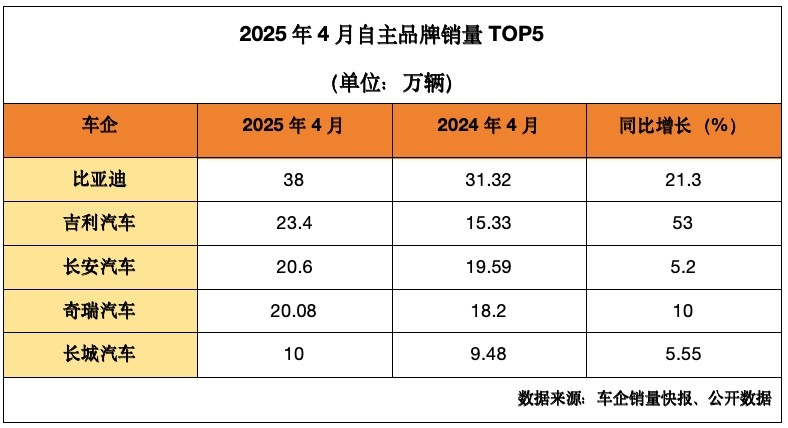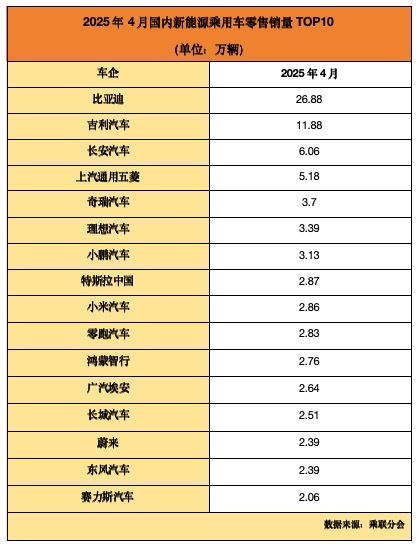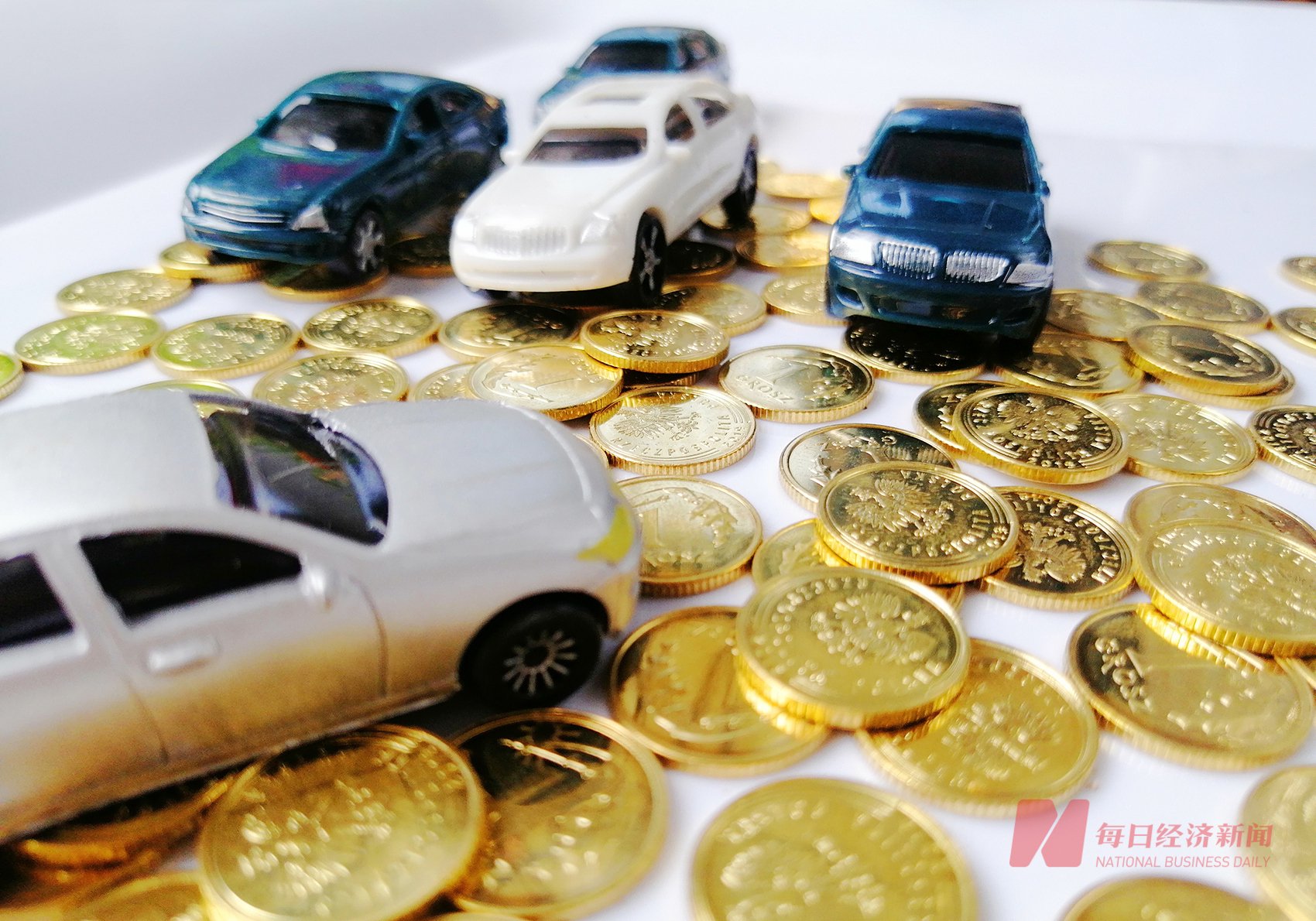On May 11, the Passenger Car Association released new data. From January to April, the national retail sales of passenger cars reached 6.872 million units, a 7.9% increase year-on-year. In April, retail sales totaled 1.755 million units, marking a 14.5% year-on-year growth but a 9.4% month-on-month decline. April’s retail sales growth represents the highest rate for that month in nearly a decade. It breaks the trend of low retail growth for April over the past ten years. This change further reduces the quarterly fluctuations in the automotive market. Cui Dongshu, secretary-general of the Passenger Car Association, explained, “The national ‘trade-in’ policy will start early in 2025. The subsidy policy will be straightforward. The market showed good growth at the beginning of the year, leading to a relatively mild price war and improved industry competition.” German brands experienced the most significant decline in retail market share, while domestic brands surpassed 65% market share. In April, domestic brands sold 1.15 million passenger cars, a 31% year-on-year increase, capturing 65.5% of the retail market, up 8 percentage points year-on-year. From January to April, domestic brands held a 64% retail market share, up 7.9 percentage points from last year. In contrast, mainstream joint-venture brands and luxury brands saw varying degrees of sales decline in April. Luxury car retail sales reached 170,000 units, an 18% year-on-year drop, with a retail share of 9.5%, down 3.7 percentage points. Mainstream joint-venture brands sold 440,000 units, a 3% year-on-year decline and an 8% month-on-month decline. German brands showed the most noticeable drop in retail share. In April, their share fell to 15.6%, down 3.4 percentage points year-on-year. Japanese brands held 12.2% of the share, down 2.7 percentage points. American brands had a 4.8% share, down 1.1 percentage points. Cui Dongshu attributed the sustained high growth of domestic brands to significant gains in the new energy vehicle market and export market. He noted that mainstream automakers like BYD, Geely, Chery, and Changan have shown excellent performance in their transformation and upgrades, leading to a notable increase in market share.
In April, several domestic car companies released their production and sales data. BYD sold over 380,000 new energy vehicles, a 21.3% increase year-on-year. It became the top-selling brand among domestic manufacturers. BYD also exported about 77,100 passenger vehicles and pickups, showing a remarkable 91% growth. Geely followed closely with total sales of about 234,100 vehicles in April, a 53% increase. Geely’s new energy vehicle sales reached approximately 125,600, growing by 144%. This segment contributed over 53% to Geely’s total sales. Changan ranked third, selling about 206,100 vehicles in April, a 5.2% increase. Its new energy retail sales were around 71,300, up 46.7%. Changan’s total retail sales for Chinese brands reached about 171,200, marking an 8.3% increase. Chery sold about 200,700 vehicles in April, a 10.3% rise, just behind Changan by fewer than 6,000 units. Chery’s new energy vehicle sales reached around 61,200, a significant 85.5% increase. It also exported 87,700 vehicles, maintaining its lead in exports among Chinese car companies. All four companies excelled in new energy vehicle sales and exports in April. “As China’s new energy vehicle scale advantages emerge and market demand expands, more Chinese-made new energy brands are entering overseas markets, gaining recognition,” said Cui Dongshu in an interview with the Daily Economic News. According to the Passenger Car Association, China exported 423,000 passenger cars in April, a 2% year-on-year decline but a 7% increase from the previous month. New energy vehicles accounted for 44.6% of total exports, an increase of 14 percentage points compared to the same period last year. In April, domestic brand exports reached 340,000 units, up 0.1% year-on-year. Joint venture and luxury brand exports totaled only 80,000 units, down 10% year-on-year. Cui Dongshu emphasized that Chinese car companies must prioritize electrification and the entire industry chain’s development. They should push Chinese electric vehicles to truly enter the global market. Domestic new energy vehicles hold a market share of 73%. Mainstream joint venture brands have only a 3.4% share. In April, the domestic new energy passenger car market saw retail sales of 905,000 units, up 33.9% year-on-year but down 8.7% month-on-month. The retail penetration rate reached 51.5%, an increase of 7 percentage points from last year. Among domestic brands, the penetration rate for new energy vehicles was 72.8%. For luxury vehicles, it was 23.5%. Mainstream joint venture brands had a penetration rate of only 6.8%. In terms of monthly retail share, domestic brands achieved a new energy vehicle retail share of 73% in April, an increase of 0.4 percentage points year-on-year. Mainstream joint venture brands had a retail share of only 3.4%, down 1.5 percentage points year-on-year. From January to April, domestic new energy passenger car retail sales totaled 3.324 million units, up 35.7% year-on-year, contributing over 48% to overall passenger car sales. Regarding the current state of development for domestic new energy car companies, Cui Dongshu noted that overall, the market does not exhibit “the strong getting stronger.” Instead, it is in a phase of “mixed competition” among small and medium-sized new energy car companies. “Some small companies are gradually growing, with sales increasing rapidly from a few thousand units a month to thirty or fifty thousand,” Cui Dongshu stated. According to the Passenger Car Association, in April, 16 brands in China sold over 20,000 new energy passenger vehicles. The top ten brands by sales were BYD, Geely, Changan, SAIC-GM-Wuling, Chery, Li Auto, Xpeng, Tesla China, Xiaomi, and Leap Motor.
Mainstream domestic automakers strengthen their new energy vehicles. BYD, Geely, Changan, and SAIC-GM-Wuling perform well in retail. New force brands like Li Auto, Xpeng, Leap Motor, and Xiaomi Auto all enter the top ten. Data from the Passenger Car Association shows that new forces hold a retail share of 19.4% in April, up 3.6 percentage points year-on-year. Xpeng, Xiaomi, and Leap contribute 5.2 percentage points to this increase. Traditional domestic automakers’ independent new energy brands perform strongly, with a share of 12.6%, up 0.8 percentage points year-on-year. Cui Dongshu says new growth opportunities arise in the new energy vehicle sector. This drives rapid sales growth for companies like NIO, Xpeng, and Xiaomi Auto. “It’s not just about leading firms getting stronger. It’s about innovation ability and control over the supply chain. Those who excel will grow faster and better,” Cui tells reporters. Market competition becomes “mild,” and discounted models decrease significantly. Under policy drivers, the market sees rapid growth in the first four months of 2025, but the “price war” is more “gentle.” The Passenger Car Association reports 65 discounted models from January to April 2025, down 56 from last year. The number of discounted models in these months are 7, 21, 23, and 14, respectively. “Compared to 41 models in April last year and 19 in April 2023, this April shows a significant drop in discounted models, indicating a clear cooling of the ‘price reduction wave,'” Cui says.
In 2025, competition in the automotive market will focus more on product and service experiences. Car companies strive to enhance cost-effectiveness and competitiveness through technological innovation. On May 8, Li Auto held a launch event for the upgraded L series. The new L6, L7, L8, and L9 models debuted at prices ranging from 249,800 to 439,800 yuan (60770$). They received upgrades in core technologies like assisted driving, smart cockpit, and chassis performance. Before Li Auto, BYD announced its “more features, same price” slogan at the beginning of the year. It launched upgraded models equipped with the “Heavenly Eye” intelligent assistance system. BYD Chairman Wang Chuanfu stated that the company will invest 100 billion yuan in the second half of the intelligent era to develop AI and automotive integration, aiming for full vehicle intelligence. In addition to upgrading assisted driving technology, car companies are increasing investments in amorphous motors, high-efficiency batteries, 5C charging, and charging infrastructure. These efforts aim to enhance consumer experiences, increase user loyalty, and boost sales. For example, NIO introduced promotional policies to attract more buyers, such as offering five years of free battery swaps with car purchases. On May 10, NIO announced that four upgraded models—ES6, EC6, ET5, and ET5T—would start pre-orders, featuring the five-year free battery swap benefit. Cui Dongshu believes that competition will intensify in the second half of the year as car companies pursue annual sales targets. However, he does not expect low-level “involution” to return. “In the second half, car companies will diversify their strategies to enhance product competitiveness and capture more market share,” Cui Dongshu analyzed.


